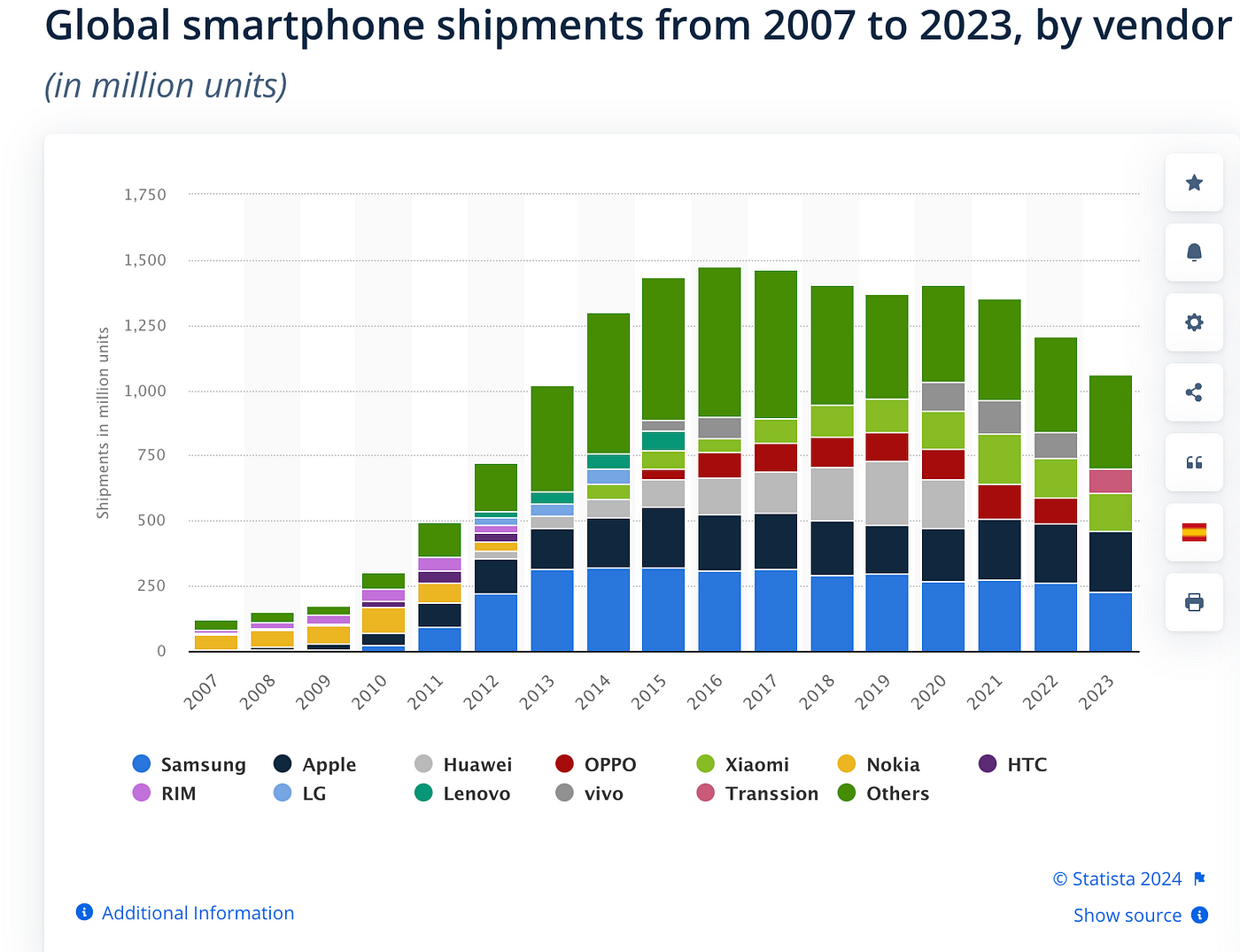
The Smartphone sales growth rate is slowing down
In 2023, the global smartphone market witnessed a remarkable surge, reaching a staggering 1.17 billion units shipped worldwide. At the forefront of this technological wave was Apple, dominating the industry with a shipment of 234.6 million smartphones, closely trailed by Samsung’s 226.6 million units. This surge marks a significant rebound from the tumultuous impact of the COVID-19 pandemic.
Supply chain shocks or market saturation?
The pandemic, a once-in-a-century event, drastically disrupted the smartphone supply chain, causing unprecedented delays and challenges. The first quarter of 2020 saw the most pronounced effect, with shipments plunging to a mere 275.8 million units — the lowest since the second quarter of 2013. This downturn affected all manufacturers, but Apple experienced the sharpest drop in shipments.

Despite these challenges, the industry displayed remarkable resilience. By the fourth quarter of 2020, Apple not only recovered but also led the market, shipping over 90 million smartphones out of a total of 386 million units in that quarter. This remarkable comeback underscores the dynamism of the smartphone market, even in the face of economic factors, the closure of physical stores, and product availability issues that initially led to a decline in sales to end users. Ultimately, the market’s recovery in the latter part of 2020 paints a picture of an industry adaptable, resilient, and ever-evolving in the face of global challenges.
Lack of Innovation and unaddressed customer pain points are a big reason
Let’s dissect the top ten challenges facing the smartphone industry, each demanding strategic attention and innovative solutions:
- Digital Distraction and Social Media Overuse: Smartphones have become central to modern communication, yet this connectivity comes with a cost. The constant influx of notifications and the allure of social media can lead to significant distractions, impacting users’ ability to concentrate and potentially affecting mental health. This issue calls for a balanced approach to technology use and mindfulness.
- Personalization Deficit: While smartphones are highly advanced, they often fall short in offering deep personalization. Users seek devices that adapt to their unique preferences and usage patterns but find themselves limited by generic settings and interfaces. This gap highlights the need for more adaptable and intuitive user interfaces.
- Complex App Ecosystem: The vast and growing app marketplace can be overwhelming. Users often struggle to navigate through countless options and find apps that truly meet their needs. This complexity necessitates a more streamlined and user-friendly approach to app discovery and management.
- Cybersecurity Vulnerabilities: As repositories of personal and sensitive information, smartphones are prime targets for cyber threats. The prevalence of hacking and data breaches underscores the need for stronger security measures and more robust data protection protocols to safeguard user privacy.
- No User Data Monetization avenues: While user data is a valuable asset for many companies, the individuals generating this data see little to no direct benefit. This disparity raises questions about data ownership and the ethical implications of data monetization, pressing the industry to consider more equitable models.
- Battery and Durability Constraints: Despite technological advancements, battery life and device durability remain significant concerns. Users desire smartphones that can keep pace with their busy lives without frequent charging or the risk of damage, calling for improvements in battery technology and more durable design.
- Environmental Concerns: The smartphone industry’s environmental impact is multifaceted, from the resources used in manufacturing to the e-waste generated by discarded devices. This ecological footprint necessitates a greater focus on sustainable practices, including recyclable materials and longer device lifespans.
- Advanced AI Integration Gap: The absence of sophisticated AI features like generalized AI, live translation, and AI coaching limits the potential of smartphones. Incorporating these advanced functionalities could revolutionize user experiences, making devices more intuitive and versatile.
- Reliance on High-Speed Internet: Smartphones’ effectiveness is often contingent on access to high-speed internet, a resource not available to all. This reliance creates a digital divide, where individuals in areas with limited connectivity cannot fully utilize their devices, highlighting the need for more inclusive technological solutions.
- Content Issues for Young Users: The easy accessibility of content on smartphones poses challenges, particularly for young users. Issues range from content addiction to exposure to inappropriate material, necessitating more effective content regulation and parental control mechanisms to protect younger audiences.

Each of these challenges represents a unique facet of the smartphone industry’s complex landscape, calling for targeted strategies and innovative thinking to drive forward a more user-friendly, secure, and sustainable future in mobile technology.
These pain points leave a huge void of AI-first phones and consumer devices. This is AI’s big opportunity
AI integration into smartphones will be a shot in the arm for consumer devices, particularly the smartphone industry
Imagine a future where you can give the “AI phone or device to your kid” and let them use it for anything without worrying about social media exposure, gaming addictions or age-inappropriate content.
AI can solve that issue and turn smartphones into AI phones “segment-focused devices”. AI phone with customized operating system for:
- School Students with all coaching support and access to super-intelligence or AGI
- University Graduates and Job-seekers
- Academicians and researchers
- Employees across industries
- Entrepreneurs/Founders
- Home Parents
- Elders and seniors
- Mid-Age job seekers
This does not mean there will be 8 types of devices, but 8 types of operating systems that can take away the smartphone distractions and evils. I am not suggesting any form of moral policing, but for students and impressionable minds, some form of content guidelines can do more good than harm.
Even adults need a break from smartphones and AI-personalized devices can give them much-needed digital detox from mindless surfing
The Relationship between Social Media and the Increase in Mental Health Problems
Social media has become an indispensable aspect of young people’s digital interactions, as they use it mostly for…
www.ncbi.nlm.nih.gov
10 WAYS IN WHICH AI WILL RESHAPE SMARTPHONES
Giving up smartphones completely is not a practical solution, because unlike a cigarette it is not purely evil. It is a mixed bag of technology that has both goodies and harmful stuff locked and intertwined together. Most consumers using a smartphone are not mature enough to choose what is great for them and after a while, they get exhausted and lose to the incoming stream of entertainment, sensational and explicit content.
I am very curious to see how the next 10 years will evolve in the consumer devices space- especially how will the 3 forces interact- Smartphones, AI devices with foundational models and intelligent edge capabilities, and the advent of metaverse/spatial computing through VR devices.
Regards,
Sidhartha Sharma
Views are personal and connect with me on Linkedin
https://www.linkedin.com/in/sidharthasharmadigitalandstrategy/

Leave a Reply